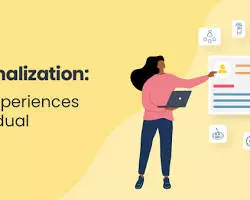Personalization Powerhouse: How CRM Drives Customer-Centric Experiences in 2024

Personalized Customer Experiences with CRM
In today’s competitive landscape, personalization is no longer a luxury; it’s an expectation. Customers crave tailored experiences that cater to their individual needs and preferences. Customer Relationship Management (CRM) systems have emerged as the engine driving personalization, enabling businesses to deliver relevant messages, offers, and experiences that resonate with each customer, fostering loyalty and driving growth.
The Power of Personalization
Personalization goes beyond simply using a customer’s name in an email. It involves understanding their unique characteristics, behaviors, and preferences, and tailoring your interactions accordingly. Personalized experiences lead to:
- Increased Engagement: Customers are more likely to engage with content and offers that are relevant to their interests and needs.
- Higher Conversion Rates: Personalized messages and offers drive higher conversion rates, as customers feel understood and valued.
- Improved Customer Satisfaction: Tailored experiences create a positive emotional connection with your brand, leading to increased satisfaction and loyalty.
- Enhanced Brand Reputation: Customers who feel valued are more likely to recommend your brand to others, boosting your reputation and attracting new customers.
- Increased Revenue: Personalization can lead to a significant increase in revenue, as customers are more likely to purchase from brands that understand their needs.
How CRM Fuels Personalization
CRM systems are a treasure trove of customer data, providing the insights needed to create personalized experiences. This data includes demographics (age, gender, location), behavior (purchase history, website interactions), and preferences (interests, communication channels). CRM software offers powerful personalization tools that allow you to:
- Segment Your Audience: Divide your customer base into smaller, more specific groups based on shared characteristics, enabling targeted messaging and offers.
- Tailor Your Messages: Craft personalized messages that address individual customer needs and interests, using their name, referencing past purchases, and recommending relevant products or services.
- Deliver Dynamic Content: Use dynamic content to display different content to different users based on their preferences and behavior.
- Create Personalized Offers: Offer discounts, promotions, and recommendations based on individual customer purchase history and interests.
- Optimize Customer Journeys: Map out the customer journey and identify opportunities for personalization at each touchpoint.
Best Practices for Personalization with CRM
To maximize the impact of personalization, consider these best practices:
- Start with Data: Gather as much customer data as possible, including demographics, behavior, and preferences.
- Use a Customer-Centric Approach: Put the customer at the center of your personalization efforts. Focus on understanding their needs and preferences, and tailor your interactions accordingly.
- Be Relevant and Timely: Deliver personalized messages and offers at the right time and through the right channels.
- Measure and Optimize: Track the performance of your personalization efforts and make adjustments based on data and feedback.
- Respect Customer Privacy: Be transparent about how you collect and use customer data, and give customers control over their data.
Conclusion
Personalization is the key to building strong customer relationships and driving business growth in 2024. CRM systems provide the data and tools needed to deliver personalized experiences that resonate with customers and drive results. Embrace personalization as a core pillar of your marketing and sales strategy, and watch your business thrive in the era of the customer.

Fundamentals of CRM with Dynamics 365 and Power Platform

Marketing Automation For Dummies

Successful Direct Marketing Methods: Interactive, Database, and Customer-based Marketing for Digital Age (BUSINESS BOOKS)

CRM & FFHH: analysis of real accidents

Connected CRM: Implementing a Data–Driven, Customer–Centric Business Strategy

Special Edition Using Microsoft CRM
Related Guides: See all
- AI-Powered CRM: Supercharging Customer Relationships with Intelligent Automation and Predictive Insights in 2024
- Omnichannel Engagement with CRM: Crafting Seamless Customer Journeys in 2024
- Customer Segmentation Mastery with CRM: Unlock Personalized Marketing and Sales Strategies in 2024
- Mastering the Customer Journey with CRM: Elevate Experiences and Boost Loyalty in 2024
- Social CRM: Building Stronger Customer Relationships Through Social Media in 2024
- Cloud CRM: Revolutionizing Business Agility and Scalability in 2024
- Mobile CRM: Empowering Sales and Service Teams on the Go in 2024
- CRM Integration and API: Unifying Your Business Ecosystem for Seamless Operations in 2024
- Data-Driven Decisions with CRM: Harness the Power of Reporting and Dashboards in 2024